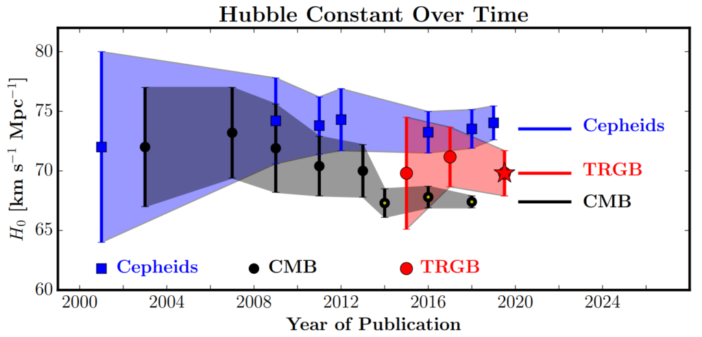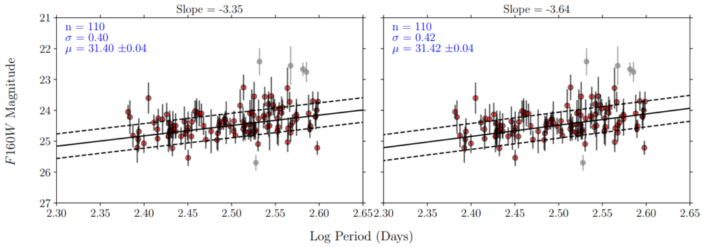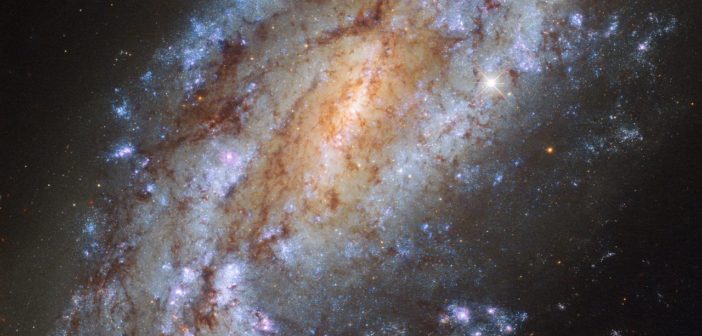Editor’s note: Astrobites is a graduate-student-run organization that digests astrophysical literature for undergraduate students. As part of the partnership between the AAS and astrobites, we occasionally repost astrobites content here at AAS Nova. We hope you enjoy this post from astrobites; the original can be viewed at astrobites.org.
Title: Hubble Space Telescope Observations of Mira Variables in the Type Ia Supernova Host NGC 1559: An Alternative Candle to Measure the Hubble Constant
Authors: Caroline D. Huang, Adam G. Riess, Wenlong Yuan, Lucas M. Macri, Nadia L. Zakamska, et al.
First Author’s Institution: The Johns Hopkins University
Status: Submitted to ApJ
Disclaimer: The author was not involved in this work in any way.
If you want to figure out the fate of our universe, the value of the Hubble Constant (H0) would be handy to have. H0 tells us how fast the universe is expanding right now… I mean now… actually now — you get the picture. The Hubble Constant isn’t constant over time. Taken with other quantities, its current value can tell us a lot about the universe, such as its age and ultimate fate.
As great as H0 is, though, it’s a bit tricky to measure. And to complicate things, the measured value of H0 changes with the measurement method. Currently, Planck measurements of the cosmic microwave background (CMB) return H0 = 67.4 ± 0.5 km/s/megaparsec (km/s/Mpc). This value is significantly smaller than the measurement obtained by using the distances and redshifts/velocities of distant galaxies, which is H0 = 74.03 ± 1.42 km/s/Mpc. The difference between these two measurements has been increasing since the 1990s as the measurements have been refined (see Figure 1), leading astronomers on both sides to scrutinize their methods for unaccounted errors.

Figure 1: Measured values of H0 over time, showing how the CMB (black points) and Cepheid (blue points) measurements have been diverging. The red points come from H0 measurements using the Tip of the Red Giant Branch (TRGB). [Freedman et al., 2019]
One of these objects could be Mira variable stars (Miras). In this paper, the authors search for Miras in NGC 1559 using Hubble Space Telescope (HST) observations. NGC 1559 has hosted another, better understood distance indicator — a Type Ia supernovae — making it a good place to test how Miras can perform as extragalactic distance indicators.
O, See the Miras!
Miras are Asymptotic Giant Branch stars, meaning that they’ve run out of helium to burn in their cores. Their cores are inert and contain oxygen and carbon, and their outer shells consist of still-burning hydrogen. The outer shell puffs out as the star grows hotter, then cools down and shrinks. This is what causes the periodic brightness variations in a Mira: it gets bigger and brighter, then smaller and dimmer. Miras are named for their archetype, Mira, which is also known as O Ceti since it’s located in the constellation of Cetus.

Figure 2: The eponymous Mira, also known as O Ceti, as seen in different wavelengths by the HST. [M. Karovska (Harvard-Smithsonian CfA)/ NASA/ESA]
Like Cepheids, Miras have a period–luminosity relation (PLR) that gives them their power as distance indicators. Mira PLRs are particularly distinct in the infrared. O-rich Miras with periods less than 400 days follow PLRs most tightly, so they’re currently the most reliable Mira distance indicators.
Pulling Miras Out of the Mire
To find Miras in NGC 1559, the authors use infrared observations taken by the HST’s Wide Field Camera 3. They identified the objects that were most likely to be genuinely variable. Then they determined the most likely periods of those objects, testing periods between 100 and 1000 days (since Mira periods typically lie within that range).
The authors then applied cuts based on the amplitude of the objects’ variations in brightness to select the O-rich Miras from the sample. The authors use techniques from other studies to estimate the degree of C-rich Mira contamination.
The authors end up with sample of 115 O-rich Miras. Since their sample is small, the authors draw on PLRs determined from the Large Magellanic Cloud (LMC) while fitting the NGC 1559 PLR (see Figure 3).

Figure 3: PLRs for the NGC 1559 Miras obtained using two different observed PLRs of LMC Miras from the OGLE Project (left) and Yuan et al. 2017b (right). The x-axis is the log of the period in days and the y-axis is magnitude in an infrared filter used on the HST. n = number of Miras; σ = scatter or spread in the relation; μ = distance modulus or the relation between apparent magnitude and absolute magnitude. [Huang et al. 2019]
Another Way Out
Before coming up with a measurement of H0, the authors compare the NGC 1559 PLR to the Mira PLR they obtained for NGC 4258 in a previous study. NGC 4258 hosts another reliable distance indicator: a water megamaser (a maser produces radiation by using particles that are stimulated by long wavelengths of light). The authors calibrate the NGC 1559 Miras using the megamaser distance to NGC 4258.
Using the distances to the LMC, NGC 4258, and NGC 1559 with a sample of Miras with consistent periods gives — *drumroll* — H0 = 73.3 ± 3.9 km/s/Mpc. This value is consistent with the Cepheid-based value of H0 = 74.03 ± 1.42 km/s/Mpc within reasonable expectations on measurement errors.
With this study and Huang et al. (2018) the authors have shown that Miras have great potential as extragalactic distance indicators. As tensions between measurements of H0 increase, independent distance indicators like Miras only grow in importance.
About the author, Tarini Konchady:
I’m a third-year graduate student at Texas A&M University. Currently I’m looking for Mira variables in optical to help calibrate the extragalctic distance ladder. I’m also looking for somewhere to hide my excess yarn and crochet hooks (I’m told I may have a problem).
